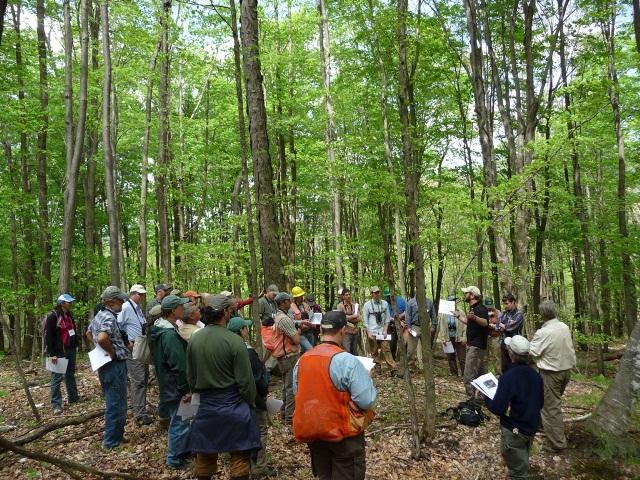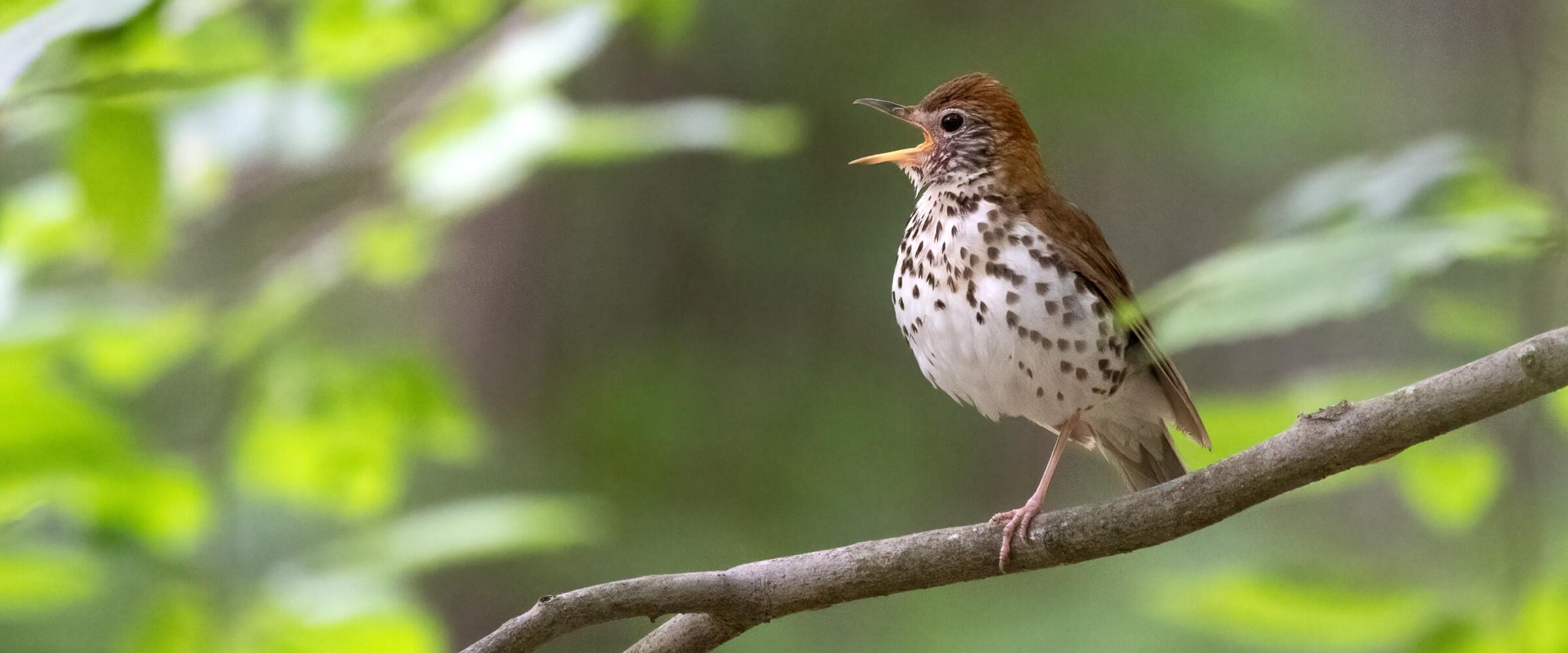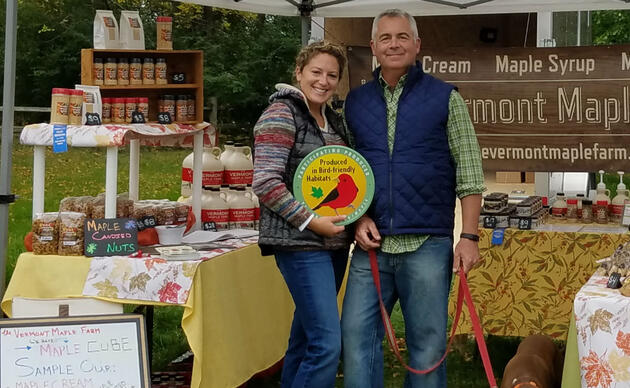Today, the original idea and program efforts of the Foresters for the Birds program, initiated in 2008, continues to thrive through what is now the Woods, Wildlife, and Warblers program (a landowner technical assistance program) and Audubon's Forester Training and Endorsement program.
What is Foresters for the Birds?
Foresters for the Birds is an innovative project that works to keep forests as forests and common birds common by helping landowners integrate the practices of timber and songbird habitat management. The project was established through a partnership between Audubon Vermont and the Vermont Department of Forests, Parks, and Recreation in 2008. It has grown to become a network of foresters, biologists, and forest landowners across Vermont and the Atlantic Flyway who are working together to make a positive difference for forests, birds, and land stewardship in the region.
---
Enduring Project Vision and Long-term Outcomes
We envision healthy forests that provide suitable breeding and post-breeding habitat conditions for a suite of priority birds and sustained yields of timber and other forest products and services along the Atlantic Flyway.
- Forest plans that manage for bird habitat and timber will be the norm along the flyway.
- Parcelization and fragmentation rates will be reduced in priority forest blocks.
- Priority bird species populations will stabilize or increase along the flyway.
How To Get Involved
- Explore Audubon's Woods, Wildlife and Warblers program and Forester Training and Endorsement Program. Audubon biologists are available to help foresters assist landowners with integrating timber and songbird habitat management through services including bird habitat assessments, management plan reviews, and project consultations.
- Attend a workshop or tour. Check Audubon Vermont’s calendar of events for upcoming programs. Our workshops are collaborative, friendly, and stimulating. Topics covered often include: bird ID and habitat associations, how to assess forest bird habitat, and silviculture with birds in mind.
- Visit a Forestry for the Birds Demonstration Site to see examples of timber management with bird in mind.
- Learn the Birder’s Dozen by sight and sound. Use the Birds with Silviculture in Mind pocket guide to help you and when communicating with landowners.
- Start assessing bird habitat as part of your timber cruises. For general information and ideas, check out A Guide to Integrating Bird Habitat Assessment into Timber Inventory. For more specific ideas and information, look at our Integrated Monitoring Protocol and field data forms.
- Use Silviculture with Birds in Mind options when writing plans and making sales. These options are approved for use in UVA plans and some qualify for NRCS incentive funding on non-commercial jobs.
- Questions? Contact us.

Testimonials
This was by far, one of the best workshops, maybe the best- I have ever attended. It was well organized, engaging, entertaining and all involved were excited and enthusiastic about the subject matter. It was obvious that a great deal of effort went into putting on this workshop and that all involved have a passion for educating all of us "dirt foresters"! Thank you! Thank You!!!! – Foresters for the Birds workshop participant
The Foresters for the Birds project is a great example of a way forward that integrates Vermont’s working forests with migratory bird habitat management goals. It’s the strong partnership between foresters, biologists, and woodland owners that makes this project unique. – Roger Monthey, USFS Forest Stewardship Program
The best part about this project is the cooperation and communication between different environmentally-oriented groups and making wildlife managers out of foresters and foresters out of wildlife biologists. – Foresters for the Birds workshop participant
I probably would not create those larger gaps up to ¾ acre in size without the toolkit. I would do more individual tree selection and not cut as heavily. For me personally that’s been a big thing to see that cutting a little heavier is good in a number of ways – good for songbirds and for better high quality regeneration. – Rose Beatty, consulting forester, Vermont
I was out with a landowner in his new woodlot, 45 acres on a nasty cold day… it was sleeting. I heard a winter wren. I was telling him all bout the little birds and how much I like them. We went towards the sound and eventually got to a place where we could see it. We talked about its habitat and migration. On that walk, we also saw an Eastern Wood-peewee in a small gap. Birds were not at all on his list of objectives or interest before, but you can bet they were after the walk. They are on his radar screen now and definitely an interest. – Alan Calfee, consulting forester, Calfee Woodland Management, Vermont
We have the Stokes guide birdsongs; my business partner, Kathy, has them on her iPod. When we sit down for lunch or a snack in the woods, we are always listening to the songs and talking about what birds might be here or should be here. It helps to know the birds and connect the birds to the habitat. It’s cool to see birds that have been around you your whole life that you’ve never noticed before. - Frank Hudson, consulting forester, Not Just Trees, Inc., Vermont
The Foresters for the Birds project adds diversity and excitement to my work. I have learned about birds on my own, but was using that knowledge more anecdotally than specifically. The work that has gone into developing these bird-habitat tools has helped me be more specific with how various management activities affect bird habitat. I do feel that a push from a landowner has been necessary to get me more familiar with actually using the materials to write my management plans. – Tii McLain, consulting forester, Vermont
As a consultant, the Foresters for the Birds toolkit has been a great tool for communicating with clients. I’ve shown landowners the materials and pictures, and I say 'this is what you can do and this is how it’s going to improve habitat for birds.' You can see the light bulb go off over their heads! -- Scott Sylvester, consulting forester, Massachusetts
The forest bird habitat assessment of the Chester Town Forest really helped me feel confident about my prescriptions and clearly communicate the intent of enhancing bird habitat - especially to people who might not like the idea of cutting trees for timber, but are in favor of wildlife habitat improvement. The report was very useful. It was laid out well and the listing of birds that would benefit from desired conditions was information I wouldn't have been able to generate on my own. It’s a great resource. -- Sam Schneski, Windham & Windsor County Forester, Vermont
How you can help, right now
Donate to Audubon
Help secure a future for birds at risk from climate change, habitat loss and other threats. Your support will power our science, education, advocacy and on-the-ground conservation efforts.
Visit Audubon
It's always a good time to visit the Audubon Center. Trails are open to the public year-round. Visit us daily from dawn until dusk! Donations are appreciated.
Events
Adults, preschoolers, foresters, photographers, sugarmakers and families will all find opportunities to connect with nature.





